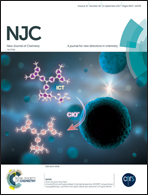Structurally different mono-, bi- and trinuclear Pd(ii) complexes and their DNA/protein interaction, DNA cleavage, and anti-oxidant, anti-microbial and cytotoxic studies†
Abstract
A series of new structurally different Pd(II) complexes was obtained by the reactions between K2[PdCl4], 3-methoxysalicylaldehyde-4(N)-substituted thiosemicarbazone [H2L1–H2L4] and bis(diphenylphosphino)ethane [dppe]. All the complexes were characterized by using various spectral techniques (IR, electronic, 1H-NMR and mass spectroscopy). The crystal structures of complexes 1, 3, 4 and 3a & 4a were determined using X-ray crystallographic technique. The interactions of the new complexes with calf thymus DNA (CT-DNA) and bovine serum albumin (BSA) were evaluated using various spectroscopic methods, which showed the interaction potential of the complexes with CT-DNA and BSA. Further, they cleaved supercoiled DNA pBR322. The anti-oxidant profiles of the complexes were found to be better than the standards against 2,2′-diphenyl-1-picrylhydrazyl radicals (DPPH) and superoxide anion radicals. The antibacterial activity of the complexes against five pathogenic bacteria such as Staphylococcus aureus, Salmonella typhi, Escherichia coli, Bacillus subtilis and Pseudomonas aeruginosa was found to be better than their parent ligands. The complexes exhibited potential cytotoxicity against human breast cancer cells (MCF-7) in the following order: 4 > 3 > 1 > cisplatin > 2.



 Please wait while we load your content...
Please wait while we load your content...